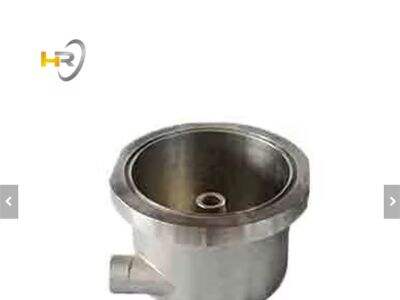Bedrijven moeten goed nadenken over hoeveel het kost om producten te maken die ze produceren. Er zijn verschillende manieren om dingen te maken, maar twee van de meest voorkomende methoden zijn spuitgieten en plaatmetaalbewerking. Maar om te bepalen welke het beste voor hen is, moeten bedrijven, waaronder Huarui, goed kijken naar de kosten van deze twee methoden. Het is tijd om ze even te vergelijken, qua kosten en om te weten wat ze onderscheidt.
Wat is spuitgieten en plaatbewerking?
Laten we eerst eens kijken naar de context van spuitgieten en plaatbewerking.
Het spuitgietproces is speciaal omdat het gesmolten metaal in de mal wordt gespoten. Aluminium spuitgietstukken metalen onderdeel wordt gegoten met behulp van deze specifieke mal. Daarna hardt het metaal uit en neemt de vorm van de mal aan wanneer het afkoelt. Dit is handig voor zowel nauwkeurigheid als details in een onderdeel.
Een andere methode is plaatbewerking, waarbij grotere platen metaal worden gesneden, gebogen en gevormd om uw product te vormen. De drie meest gebruikte soorten metaal zijn staal, messing en aluminium, maar ze vereisen een reeks processen voordat ze een eindproduct kunnen worden, zoals het snijden van het metaal in stukken, het vervolgens buigen in de gewenste vorm en het uiteindelijk lassen.
Beide processen transformeren metaal in een gewenste vorm, maar ze doen dit met verschillende technieken. Dit kan van invloed zijn op de kosten en de productietijd.
Spuitgieten versus plaatbewerking: kostenvergelijking
Laten we nu eens dieper ingaan op de kosten van beide methoden. Spuitgieten is doorgaans duurder dan plaatmetaalbewerking. Een belangrijke reden hiervoor is dat u bij spuitgieten eerst een mal moet maken. De initiële kosten voor het maken van een mal kunnen hoog zijn. Nog een nadeel is dat de machines en apparatuur die worden gebruikt om een spuitgietproces uit te voeren doorgaans duurder zijn dan die voor plaatmetaalbewerking.
Maar als een bedrijf veel onderdelen moet produceren, kan spuitgieten over het geheel genomen geld besparen. Dit komt door de veel snellere productiesnelheid van onderdelen die mogelijk is met spuitgieten dan met plaatbewerking. Zelfs als de initiële kosten hoger zijn, kan de productiesnelheid de kosten per onderdeel lager maken bij het produceren van een aantal onderdelen tegelijk.
Omgekeerd, hoewel plaatbewerking op het eerste gezicht een meer economische optie lijkt, kunnen er extra kosten ontstaan. Plaatbewerking vereist bijvoorbeeld vaak meer werknemers voor elk van de betrokken taken. Meer arbeid kan ook leiden tot hogere prijzen, vooral als de metalen componenten complexe vormen moeten hebben. Bovendien kan dikker of harder plaatwerk uw werk moeilijker maken. Deze complicatie kan leiden tot meer afval, wat uiteindelijk kan bijdragen aan hogere totale productiekosten.
Wat beïnvloedt de kosten?
Er zijn een paar belangrijke factoren die de kosten van spuitgieten deel en plaatbewerkingsvergelijking. En een belangrijke reden is het type metaal dat wordt gebruikt. "Bij sommige metalen is het duurder, bij andere is het makkelijker om mee te werken," zei Sadovskiy. Bovendien is de complexiteit van zowel het onderdeel als het productieproces van cruciaal belang. Je zou denken dat zulke details duurder zouden zijn om te produceren, ongeacht de productiemethode.
Een ander belangrijk punt om te overwegen is het aantal onderdelen dat u wilt laten produceren. Voor bedrijven die veel onderdelen nodig hebben, kan spuitgieten de betere optie zijn. Dit komt doordat spuitgieten onderdelen veel sneller kan produceren, waardoor u op de lange termijn tijd en geld bespaart. Als er echter maar een paar onderdelen nodig zijn, kan plaatbewerking een betere beslissing zijn, omdat het in de beginfase goedkoper kan zijn.
Een specifiek voorbeeld
Laten we een concreet voorbeeld nemen om de kosten te zien. Stel dat Huarui een groot aantal metalen tandwielen moet produceren voor een product en dat deze tandwielen complexe ontwerpen hebben met veel fijne structuren.
De initiële kosten zullen hoog zijn als Huarui kiest voor spuitgieten. Dat betekent dat ze eerst een mal moeten produceren, wat kostbaar kan zijn. Zodra de mal is gemaakt, kan elk afzonderlijk tandwiel voor veel minder worden geproduceerd. In dit geval zouden ze moeten kiezen voor spuitgieten, omdat dit de betere investering zal zijn gezien het volume aan tandwielen dat ze willen produceren.
Als Huarui echter besluit om plaatmetaalbewerking te omarmen, zullen de eerste kosten lager zijn omdat ze geen mal hoeven te maken. Maar er is een addertje onder het gras: elke kit zou meer kosten, omdat het produceren van geavanceerde tandwielen echter enorm veel arbeid vereist. Er is ook meer afval in het productieproces, wat het hele proces duurder maakt. In dit geval is plaatmetaalbewerking misschien niet de meest kosteneffectieve manier voor hen om tandwielen te produceren, omdat ze grote hoeveelheden tandwielen nodig hebben.
Conclusie
Nou, als we spuitgieten vergelijken met op maat gemaakte plaatwerkonderdelen fabricagekosten zijn niet zo eenvoudig. Spuitgieten kost over het algemeen meer in eerste instantie vanwege de kosten van de mal, maar na verloop van tijd blijkt het vaak zuiniger als er snel een groot aantal onderdelen wordt geproduceerd. Aan de andere kant lijkt plaatbewerking op het eerste gezicht misschien goedkoper, maar het kost in feite meer arbeid en genereert afval, waardoor de totale kosten stijgen. Huarui en anderen moeten de kosten en baten van elke aanpak zorgvuldig overwegen en afwegen om te bepalen welke het beste past bij hun unieke vereisten. Deze verschillen zijn een teken dat de stad hun producten goed produceert.

 EN
EN






































